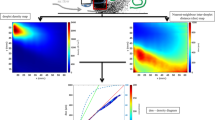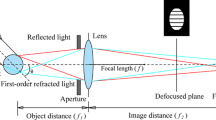Abstract
A novel method for conditional measurement of droplet size distribution within droplet clusters in sprays is reported in this paper. The salient feature of this approach is the application of Voronoi analysis to droplets measured by the ILIDS technique, which is capable of providing planar measurement of size of individual droplets in a spray. The principle of the present technique is based on calculation of Voronoi tessellations around the droplets identified in the ILIDS image processing. Comparison of the distribution of areas of the Voronoi cells with that from a random distribution of droplets described by a Poisson function facilitates classification of the Voronoi cells as clusters or voids. Thus, individual clusters of droplets and void areas are recognized by identifying the interconnected cells. Since the sizes of individual droplets are known, conditional measurement of droplet size distribution within clusters and voids is possible. Since droplet images are always defocused in the ILIDS technique, correct identification of droplet centers is important, which is described in the paper. It is shown that in spite of the low validation ratio in the ILIDS image processing, the results on the cluster and void characterization agree well with those by Voronoi analysis of PIV images. The novel method is demonstrated for an air-assist spray where ILIDS measurements are obtained far downstream of the injector exit. Interestingly, the characteristic droplet size within droplet clusters is found to be smaller than that in voids, indicating size-based preferential segregation of droplets due to clustering in sprays.
Graphical abstract















Similar content being viewed by others
References
Akamatsu F, Miutani Y, Katsuki M, Tsushima S, Cho YD (1996) Measurement of the local group combustion number of droplet clusters in a premixed spray stream. In: Symposium (international) on combustion, vol 26, pp 1723–1729. Elsevier, London
Aliseda A, Cartellier A, Hainaux F, Lasheras JC (2002) Effect of preferential concentration on the settling velocity of heavy particles in homogeneous isotropic turbulence. J Fluid Mech 468:77–105
Balachandar S, Eaton JK (2010) Turbulent dispersed multiphase flow. Annu Rev Fluid Mech 42:111–133
Chen L, Goto S, Vassilicos JC (2006) Turbulent clustering of stagnation points and inertial particles. J Fluid Mech 553:143–154
Coleman SW, Vassilicos JC (2009) A unified sweep-stick mechanism to explain particle clustering in two-and three-dimensional homogeneous, isotropic turbulence. Phys Fluids 21(11):113301
Damaschke N, Nobach H, Nonn TI, Semidetnov N, Tropea C (2005) Multi-dimensional particle sizing techniques. Exp Fluids 39(2):336–350
Ferenc J-S, Néda Z (2007) On the size distribution of poisson Voronoi cells. Phys A Stat Mech Appl 385(2):518–526
Ferrante A, Elghobashi S (2003) On the physical mechanisms of two-way coupling in particle-laden isotropic turbulence. Phys Fluids 15(2):315–329
Glover AR, Skippon SM, Boyle RD (1995) Interferometric laser imaging for droplet sizing: a method for droplet-size measurement in sparse spray systems. Appl Opt 34(36):8409–8421
Hardalupas Y, Taylor AMKP, Whitelaw JH (1994) Mass flux, mass fraction and concentration of liquid fuel in a swirl-stabilized flame. Int J Multiphase Flow 20:233–259
Hardalupas Y, Sahu S, Taylor AMKP, Zarogoulidis K (2010) Simultaneous planar measurement of droplet velocity and size with gas phase velocities in a spray by combined ILIDS and PIV techniques. Exp Fluids 49(2):417–434
Heinlein J, Fritsching U (2006) Droplet clustering in sprays. Exp Fluids 40(3):464–472
Lampa A, Fritsching U (2013) Large eddy simulation of the spray formation in confinements. Int J Heat Fluid Flow 43:26–34
Lian H, Charalampous G, Hardalupas Y (2013) Preferential concentration of poly-dispersed droplets in stationary isotropic turbulence. Exp Fluids 54(5):1525
Lian H, Soulopoulos N, Hardalupas Y (2017) Evaluation of the topological characteristics of the turbulent flow in a ‘box of turbulence’through 2D time-resolved particle image velocimetry. Exp Fluids 58(9):118
Maeda M, Kawaguchi T, Hishida K (2000) Novel interferometric measurement of size and velocity distributions of spherical particles in fluid flows. Meas Sci Technol 11(12):L13
Maeda M, Akasaka Y, Kawaguchi T (2002) Improvements of the interferometric technique for simultaneous measurement of droplet size and velocity vector field and its application to a transient spray. Exp Fluids 33(1):125–134
Manish M, Sahu S (2018) Analysis of droplet clustering in air-assist sprays using Voronoi tessellations. Phys Fluids 30(12)
Manish M, Sahu S (2019) Droplet clustering and local spray unsteadiness in air-assisted sprays. Exp Therm Fluid Sci 100:89–103
Maxey MR (1987) The gravitational settling of aerosol particles in homogeneous turbulence and random flow fields. J Fluid Mech 174:441–465
McDonell VG, Adachi M, Samuelsen GS (1992) Structure of reacting and non-reacting swirling air-assisted sprays. Combus Sci Technol 82(1–6):225–248
Monchaux R, Bourgoin M, Cartellier A (2010) Preferential concentration of heavy particles: a Voronoï analysis. Phys Fluids 22(10):103304
Monchaux R, Bourgoin M, Cartellier A (2012) Analyzing preferential concentration and clustering of inertial particles in turbulence. Int J Multiphase Flow 40:1–18
Obligado M, Missaoui M, Monchaux R, Cartellier A, Bourgoin M (2011) Reynolds number influence on preferential concentration of heavy particles in turbulent flows. J Phys Conf Ser 318:052015 (IOP Publishing)
Obligado M, Teitelbaum T, Cartellier A, Mininni P, Bourgoin M (2014) Preferential concentration of heavy particles in turbulence. J Turbul 15(5):293–310
Sahu S (2011) Experimental study of isothermal and evaporative sprays. PhD thesis, Imperial College London
Sahu S, Hardalupas Y, Taylor AMKP (2014) Simultaneous droplet and vapour-phase measurements in an evaporative spray by combined ILIDS and PLIF techniques. Exp Fluids 55(2):1673
Sahu S, Hardalupas Y, Taylor AMKP (2016) Droplet–turbulence interaction in a confined polydispersed spray: effect of turbulence on droplet dispersion. J Fluid Mech 794:267–309
Sahu S, Hardalupas Y, Taylor AMKP (2018) Interaction of droplet dispersion and evaporation in a polydispersed spray. J Fluid Mech 846:37–81
Saw EW, Shaw RA, Ayyalasomayajula S, Chuang PY, Gylfason Á (2008) Inertial clustering of particles in high-Reynolds-number turbulence. Phys Rev Lett 100(21):214501
Sornek RJ, Dobashi R (2000) Effect of turbulence on spatial distribution and group behavior of droplet in a spray flame. Combus Sci Technol 611(1):191–211
Sumbekova S, Cartellier A, Aliseda A, Bourgoin M (2017) Preferential concentration of inertial sub-Kolmogorov particles: the roles of mass loading of particles, Stokes numbers, and Reynolds numbers. Phys Rev Fluids 2(2):024302
Tennekes H, Lumley JL (1972) A first course in turbulence. MIT Press, Cambridge
Tropea C (2011) Optical particle characterization in flows. Annu Rev Fluid Mech 43:399–426
Tsushima S, Saitoh H, Akamatsu F, Katsuki M (1998) Observation of combustion characteristics of droplet clusters in a premixed-spray flame by simultaneous monitoring of planar spray images and local chemiluminescence. In: Symposium (international) on combustion, vol 27, pp 1967–1974. Elsevier, London
Wood AM, Hwang W, Eaton JK (2005) Preferential concentration of particles in homogeneous and isotropic turbulence. Int J Multiphase Flow 31(10):1220–1230
Yang TS, Shy SS (2005) Two-way interaction between solid particles and homogeneous air turbulence: particle settling rate and turbulence modification measurements. J Fluid Mech 526:171–216
Zimmer L, Ikeda Y (2003) Simultaneous laser-induced fluorescence and mie scattering for droplet cluster measurements. AIAA J 41(11):2170–2178
Author information
Authors and Affiliations
Corresponding author
Ethics declarations
Conflict of interest
The authors declare that they have no conflict of interest.
Additional information
Publisher's Note
Springer Nature remains neutral with regard to jurisdictional claims in published maps and institutional affiliations.
Rights and permissions
About this article
Cite this article
Boddapati, V., Manish, M. & Sahu, S. A novel approach for conditional measurement of droplet size distribution within droplet clusters in sprays. Exp Fluids 61, 42 (2020). https://doi.org/10.1007/s00348-019-2867-2
Received:
Revised:
Accepted:
Published:
DOI: https://doi.org/10.1007/s00348-019-2867-2




